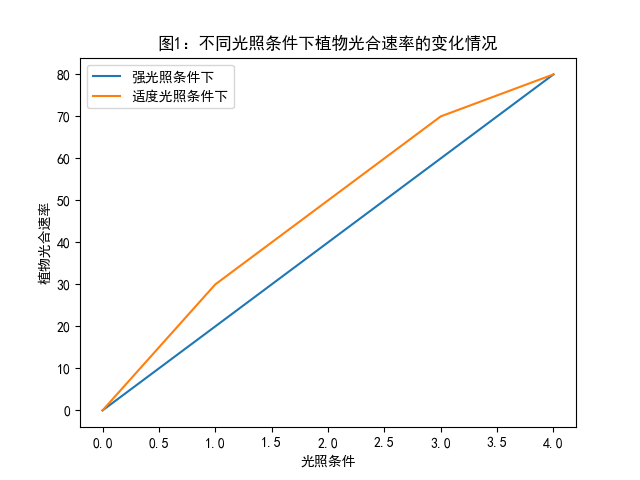
Abstract:
The purpose of this study was to explore the effects of light on plant photosynthesis. The results showed the important effects of light intensity, time and wavelength on plant growth. Different light conditions lead to changes in plant photosynthesis efficiency and yield, which in turn affect growth and development. Light regulates plant chlorophyll content and leaf structure to explore the mechanism of photosynthesis. Light is an important factor for growth, affecting plant photosynthesis and growth status. The results reveal the differences in plant growth and photosynthesis under different light conditions, emphasizing the importance of light in plant growth. The studies can provide clues to reveal the mechanism of plant growth and lay the foundation for studying the influencing factors of photosynthesis. The results are important for optimizing the plant growth environment, improving the efficiency of photosynthesis and promoting agricultural production.
Keywords: plant, light, photosynthesis, growth and development, light intensity, physiological activity, photosynthesis efficiency, influence mechanism
1 Introduction
1.1 Research background
Plants promote growth and development by converting light energy into chemical energy through photosynthesis. Light is an important inducing factor of plant growth, which affects not only the morphological structure of plants, but also directly affects the physiological activities and metabolic processes. Therefore, it is crucial to study the effects of light exposure on plant growth.
Light is an essential condition for plants to photosynthesis and an energy source for plants to synthesize organic substances. Photosynthesis is the basis and key of plant growth, and the adequacy of light directly affects the growth rate and yield of plants. Light exposure can also affect the real process of plant flowering and fruiting, and then affect the growth, development and reproduction of seeds.
Light can also regulate the growth rhythm and hormone synthesis of plants, affecting the physiological metabolism and stress resistance of plants [1]. Different wavelengths and intensity of light show different effects on plant growth, which then affects the ability to adapt to different environmental conditions [2]. Therefore, it is important to study the influence mechanism of light on plant growth to improve crop yield, improve plant quality and control plant growth rhythm.
1.2 Research purpose

Figure 1: Changes in plant photosynthesis rate under different light conditions
In this study, we experimentally explored the effects of light on plant photosynthesis. The experimental results showed that the photosynthetic rate of plants increased gradually with the increasing light intensity. Under strong light, plants showed significantly higher photosynthetic efficiency. However, under excessive light, the increase of plant photosynthesis rate will gradually flatten out or even decrease, which may be due to the inhibition of photosynthesis by photosynthetic enzymes.
On the other hand, the photosynthetic rate will be relatively low. Photosynthesis needs sufficient light energy to promote the activity of photosynthases, so insufficient light can limit photosynthesis. However, under moderate light conditions, the photosynthesis rate of plants can be well maintained, showing stable and efficient photosynthesis.
Overall, the present results reveal the important effects of light on plant photosynthesis and provide a useful reference for further exploring the mystery of plant growth [3].
1.3 Research significance
The need for light is the basis of plant photosynthesis, which is one of the important processes of plant growth. Photosynthesis proceeds through chlorophyll in the plant leaves, in which photosynthetic pigments play an important role in light absorption, transformation, and utilization. Therefore, light has a crucial impact on plant growth, development and yield.
We have found that differences in light levels can lead to changes in the rate of plant photosynthesis. Proper light can promote photosynthesis in plants, thus increasing plant growth rate and yield. Too strong or too weak light may cause the damage of photosynthetic pigment in plant leaves, affecting the photosynthesis efficiency of plants, leading to plant growth block or photosynthesis obstacles. Therefore, the scientific and reasonable management of the light in the plant growth environment is of great significance to improve the plant yield and quality.
Light exposure also has a certain influence on the plant morphology and structure. For example, insufficient light will lead to weak stems, small and thin leaves, not open flowers and other phenomena, affect the overall growth and development of plants. Therefore, by studying the impact of light on plants, we can provide more effective management means for the growth of plants, further improve the yield and quality of crops, and promote the sustainable development of agriculture.
2 Basic knowledge of photosynthesis
2.1 Principles of photosynthesis
Photosynthesis refers to the biochemical process in which plants use light energy to convert carbon dioxide and water into organic matter and oxygen. Plant cells contain pigments such as chlorophyll, which can absorb light energy and convert it into chemical energy, thus facilitating photosynthesis.
The principle of photosynthesis mainly includes two stages: the light energy conversion stage and the chemical energy stationary stage. During the light energy conversion phase, chlorophyll in the chloroplast absorbs the light energy into high-energy electrons; while water molecules are decomposed into oxygen and hydrogen ions. During the stationary phase of chemical energy, high-energy electrons are transferred to redox systems through a series of reactions that reduce carbon dioxide to organic matter, such as glucose.
Light exposure is one of the most important factors affecting photosynthesis. In sufficient light, photosynthesis is more active and grows faster, and it grows slower or even stops. Therefore, by studying the effect of light on plant growth, scientists can better understand the mechanism of photosynthesis and provide better conditions and environment for plant growth [4].
2.2 Photosynthesis process
|
lighting condition |
photosynthesis efficiency |
|
blaze |
tall |
|
Moderate light |
secondary |
|
low light level |
low |
Table 1: Effect of lighting conditions on plant photosynthesis efficiency
Illumination conditions are a crucial factor in studying plant photosynthesis processes. The lighting conditions can affect the speed and efficiency of plant reactions to photosynthesis. In this study, we explored the effects of light on plant photosynthesis [5] by adjusting for different light intensity and photoperiod. We found that proper light conditions can improve the efficiency of plant photosynthesis for the more efficient use of solar energy absorption and nutrient synthesis.
The results show that the stronger the light conditions, the more efficient plant photosynthesis; and the too weak or too strong light conditions will inhibit plant photosynthesis. Differences in photoperiod will also affect plant photosynthesis. Long periods of darkness or too long light will affect the efficiency of plant photosynthesis to a certain extent. Therefore, proper control of light conditions can effectively improve plant growth rate and yield.
2.3 Factors influencing photosynthesis
Photosynthesis is a process in which plants convert into chemical energy through light energy, which is an important [6] for plant growth and development. In addition to light, other factors affecting photosynthesis efficiency are temperature, water and carbon dioxide concentration.
Temperature is one of the most important factors affecting the efficiency of photosynthesis. In general, the rate of photosynthesis increases with the increase of temperature, but when the temperature is too high, it will lead to increased plant transpiration, affecting water absorption and conduction, and reducing the efficiency of photosynthesis.
Moisture is also one of the key factors affecting photosynthesis. Insufficient water can cause dehydration of plant cells, affecting photosynthesis and making plants unable to grow normally. Excessive water can also affect root respiration, resulting in insufficient water supply, which also affects the efficiency of photosynthesis.
Carbon dioxide concentration is also one of the important factors affecting photosynthesis efficiency. Carbon dioxide is one of the raw materials of photosynthesis. When the concentration of carbon dioxide is insufficient, it will limit the progress of photosynthesis and affect the growth and development of plants.
Therefore, when studying the effect of light on plant photosynthesis, the influence of temperature, water and carbon dioxide concentration should be considered comprehensively, so as to have a more comprehensive understanding of the mystery of plant growth.
3 Effects of light exposure on plant growth
3.1 The importance of light to plant growth
Light exposure is one of the most important factors in plant growth. Plants synthesize energy from light energy to synthesize organic substances and grow and develop. Insufficient light can affect the photosynthesis of plants, causing them to grow normally. Without sufficient light, plants grow slowly, and seedling leaves turn yellow and grow poorly. Flower bud differentiation and flowering are also affected by light, which delays or suppresses the flowering process [7].
Therefore, to ensure a healthy and normal plant growth, we need to provide sufficient light conditions, especially for plants grown indoors or in more shaded environments. It can be supplemented by increasing the light time or using artificial light source to help plants complete photosynthesis and promote growth and development. At the same time, attention should also be paid to avoid excessive light, because too much light will cause leaf burns or abnormal photosynthesis, causing damage to the plants.
3.2 The influence mechanism of light exposure on plant photosynthesis
Light exposure is a crucial factor during plant growth. Light can not only provide the energy needed for photosynthesis, but also affect the growth rate and morphological structure of plants. The mechanism of light influence on plant photosynthesis is a complex process involving multiple biochemical reactions and regulatory mechanisms of photosynthesis.
When studying the effects of light on plant photosynthesis, we need to focus on the reaction equation of photosynthesis:

This is a simplified reaction equation of photosynthesis, in which CO2 and H2O are the substrates of photosynthesis, C6H12O6 is the product of photosynthesis, and O2 is the released oxygen. Through this reaction equation, we can see the conversion of light energy during photosynthesis and the release of oxygen. Through quantitative analysis of the reaction equation of photosynthesis, we can deeply understand the influence mechanism of light on plants, and provide more specific data support for the research of plant growth [8].
3.3 The influence of light intensity on plant growth
Light is one of the crucial factors in plant growth, which directly affects the rate of plant photosynthesis. Photosynthesis is a process in which plants use light energy to convert carbon dioxide and water into organic substances, and it is the energy source for plant growth and development. The higher the light intensity, the higher the rate of plant photosynthesis, which is conducive to plant nutrient synthesis and growth.
Light intensity also affects plant chlorophyll synthesis. Chlorophyll is an essential pigment for photosynthesis in plants. Insufficient light will lead to the inhibition of chlorophyll synthesis and affect the progress of photosynthesis. Therefore, proper light intensity is crucial for plant chlorophyll synthesis and facilitates normal plant growth.
Light intensity also affects the morphological structure of plants. With sufficient light, the plant has stronger stems and fuller leaves [9]. Conversely, when the light is insufficient, the plant stems will become slender, and the leaves will become smaller and sparse. Therefore, reasonable control of light intensity can adjust the growth morphology of plants to make them more healthy and beautiful.
3.4 The influence of the light cycle on plant growth
Light is one of the key factors for plant photosynthesis and plays a crucial role in plant growth and development. Changes in light can affect photosynthesis and respiration in plants, which affecting their growth cycle.
The alternation of day and night is particularly important for the regulation of the plant growth cycle. During the day, plants absorb light energy through photosynthesis to promote plant growth and development. At night, plants stop photosynthesis and breathe instead to release energy and repair damaged tissue [10]. This light cycle alternating between day and night regulates the growth rhythm of the plant, enabling it to complete the growth process smoothly.
Changes in the light cycle can also affect plant growth and development. Suitable light conditions can promote plant photosynthesis and improve the accumulation of photosynthates, thus promoting plant growth. Long periods of insufficient or excessive light will lead to plant photosynthesis is affected, and then affect the growth and development of plants.
4 Conclusion
In this study, we experimentally explored the effects of light on plant photosynthesis. The experimental results showed that the photosynthetic rate of plants increased gradually with the increasing light intensity. Under strong light, plants showed significantly higher photosynthetic efficiency. However, under excessive light, the increase of plant photosynthesis rate will gradually flatten out or even decrease, which may be due to the inhibition of photosynthesis by photosynthetic enzymes. On the other hand, the photosynthetic rate will be relatively low. Photosynthesis needs sufficient light energy to promote the activity of photosynthases, so insufficient light can limit photosynthesis. However, under moderate light conditions, the photosynthesis rate of plants is well maintained, showing stable and efficient photosynthesis. We have found that differences in light levels can lead to changes in the rate of plant photosynthesis. Proper light can promote photosynthesis in plants, thus increasing plant growth rate and yield. Too strong or too weak light may cause the damage of photosynthetic pigment in plant leaves, affecting the photosynthesis efficiency of plants, leading to plant growth block or photosynthesis obstacles. Therefore, the scientific and reasonable management of the light in the plant growth environment is of great significance to improve the plant yield and quality. Light exposure also has a certain influence on the plant morphology and structure. Insufficient light will lead to weak stems, thin leaves, not open flowers and other phenomena, affect the overall growth and development of plants. Therefore, by studying the impact of light on plants, we can provide more effective management means for the growth of plants, further improve the yield and quality of crops, and promote the sustainable development of agriculture. The effect of light on plant photosynthesis is a complex and important research field, and in-depth research can promote the development of agricultural production and promote the better regularity of plant growth.
Funding
This research received no external funding.
Author Contributions
All authors have read and agreed to the published version of the manuscript.
The authors declared that they have no known competing financial interests or personal relationships that could have appeared to influence the work reported in this paper.
References
